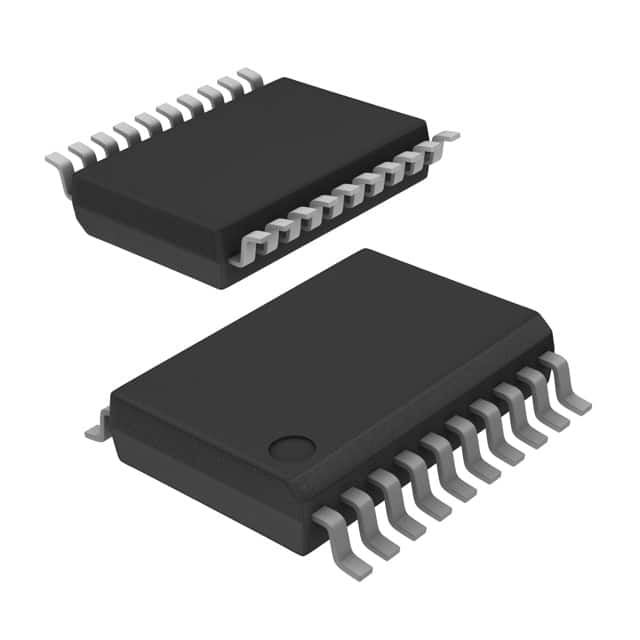ADC0801S040TS/C1,1
Basic Information Overview
- Category: Analog-to-Digital Converter (ADC)
- Use: Converts analog signals into digital data for processing or storage
- Characteristics:
- Resolution: 8 bits
- Sampling Rate: 40 kilosamples per second (ksps)
- Package: TSOP-20
- Essence: Single-channel ADC with serial output
- Packaging/Quantity: Tape and Reel, 2500 units per reel
Specifications
- Resolution: 8 bits
- Input Voltage Range: 0 to Vref
- Reference Voltage (Vref): 5V
- Sampling Rate: 40 ksps
- Power Supply Voltage: 4.5V to 6.3V
- Operating Temperature Range: -40°C to +85°C
- Package Type: TSOP-20
Detailed Pin Configuration
- VCC: Power supply voltage input
- GND: Ground reference
- IN+ / IN-: Differential analog input pins
- CS: Chip select input
- CLK: Clock input
- DOUT: Serial data output
- AGND: Analog ground reference
- REF: Reference voltage input
- DGND: Digital ground reference
- DB0 - DB7: Parallel data bus pins
Functional Features
- Single-channel ADC
- Serial output interface
- Internal reference voltage generator
- Low power consumption
- Easy interfacing with microcontrollers
Advantages
- Compact package size
- High resolution for accurate conversion
- Wide operating temperature range
- Low power consumption
- Easy integration with microcontroller systems
Disadvantages
- Limited sampling rate compared to higher-end ADCs
- Limited number of channels
Working Principles
The ADC0801S040TS/C1,1 operates by sampling the analog input voltage and converting it into an 8-bit digital value. It uses a successive approximation technique to determine the digital output based on the comparison of the input voltage with the internal reference voltage. The converted digital data is then provided through the serial output interface.
Detailed Application Field Plans
- Industrial automation systems
- Data acquisition systems
- Instrumentation and measurement devices
- Process control systems
- Robotics and motion control systems
Detailed and Complete Alternative Models
- ADC0801S080TS/C1,1: 8-bit ADC with higher sampling rate (80 ksps)
- ADC0802S040TS/C1,1: 8-bit dual-channel ADC with serial output
- ADC0804S040TS/C1,1: 8-bit ADC with parallel output
(Note: These alternative models are from the same series and share similar characteristics.)
This entry provides an overview of the ADC0801S040TS/C1,1, an 8-bit analog-to-digital converter. It includes basic information such as its category, use, characteristics, package, and quantity. The specifications, pin configuration, functional features, advantages, and disadvantages are also discussed. Additionally, the working principles, application field plans, and alternative models are provided.
قم بإدراج 10 أسئلة وإجابات شائعة تتعلق بتطبيق ADC0801S040TS/C1,1 في الحلول التقنية
Sure! Here are 10 common questions and answers related to the application of ADC0801S040TS/C1,1 in technical solutions:
Q1: What is ADC0801S040TS/C1,1? A1: ADC0801S040TS/C1,1 is a specific model of analog-to-digital converter (ADC) that converts analog signals into digital data.
Q2: What is the resolution of ADC0801S040TS/C1,1? A2: The ADC0801S040TS/C1,1 has a resolution of 10 bits, meaning it can represent analog signals with 2^10 or 1024 discrete levels.
Q3: What is the input voltage range of ADC0801S040TS/C1,1? A3: The ADC0801S040TS/C1,1 has an input voltage range of 0V to Vref, where Vref is the reference voltage provided to the ADC.
Q4: How does ADC0801S040TS/C1,1 communicate with microcontrollers or other devices? A4: ADC0801S040TS/C1,1 typically uses a parallel interface to communicate with microcontrollers or other devices. It provides digital output on multiple pins corresponding to the converted analog value.
Q5: What is the maximum sampling rate of ADC0801S040TS/C1,1? A5: The maximum sampling rate of ADC0801S040TS/C1,1 is determined by the external clock frequency provided to the ADC. It can operate at frequencies up to 640 kHz.
Q6: Can ADC0801S040TS/C1,1 be used for temperature sensing applications? A6: Yes, ADC0801S040TS/C1,1 can be used for temperature sensing applications by connecting a temperature sensor to its analog input and converting the analog temperature signal into a digital value.
Q7: Is ADC0801S040TS/C1,1 suitable for low-power applications? A7: No, ADC0801S040TS/C1,1 is not specifically designed for low-power applications. It consumes relatively higher power compared to some other ADCs available in the market.
Q8: Can multiple ADC0801S040TS/C1,1 be used together in a system? A8: Yes, multiple ADC0801S040TS/C1,1 can be used together in a system by connecting their outputs to different microcontroller pins or using multiplexers to select between them.
Q9: What are the typical applications of ADC0801S040TS/C1,1? A9: ADC0801S040TS/C1,1 is commonly used in various applications such as data acquisition systems, industrial automation, instrumentation, and control systems.
Q10: Are there any evaluation boards or development kits available for ADC0801S040TS/C1,1? A10: Yes, some manufacturers provide evaluation boards or development kits specifically designed for ADC0801S040TS/C1,1, which can help in prototyping and testing the ADC in different applications.
Please note that these answers are general and may vary depending on specific requirements and implementation details.


